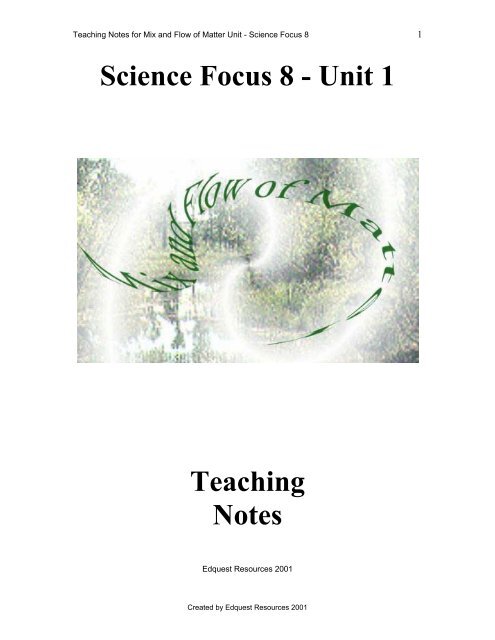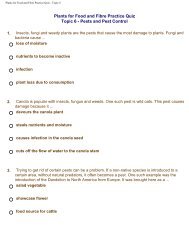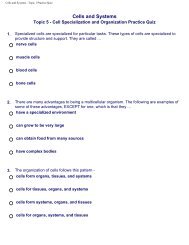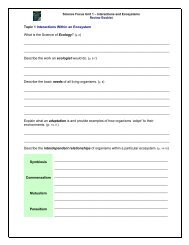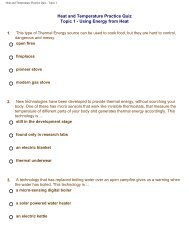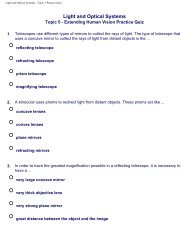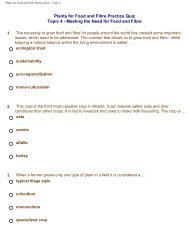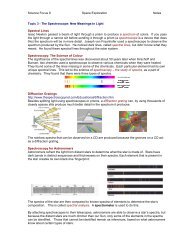Science Focus 8 - Unit 1 Teaching Notes - Ed Quest
Science Focus 8 - Unit 1 Teaching Notes - Ed Quest
Science Focus 8 - Unit 1 Teaching Notes - Ed Quest
You also want an ePaper? Increase the reach of your titles
YUMPU automatically turns print PDFs into web optimized ePapers that Google loves.
<strong>Teaching</strong> <strong>Notes</strong> for Mix and Flow of Matter <strong>Unit</strong> - <strong>Science</strong> <strong>Focus</strong> 8 7Topic 3 – Separating Earth’s Mixtures ( pgs. 27 – 38 )The Earth is rich in natural mixturesSeparating Mixtures- when fluids are used to make solids flow, the solids must later berecovered- separation methods are designed to take advantage of the uniqueproperties of the substances that have been mixedDesalinating Water- the ‘desert tent’ method (much like distillation) is inexpensive, but slow,and only practical in areas which receive a lot of bright sunlight- desalination plants, along the Red Sea, use lots of energy and arevery expensive to operate- the process of removing water from a solution is called dehydration- the solvent (which is the water, in most cases) is separated from thesolution by means of evaporation- distillation is a separation method that allows all the liquid fractions ofa mixture to be separated from each other and collected independentlyhttp://lorien.ncl.ac.uk/ming/distil/distil0.htm- all seawater contains salt, but in varying amounts - from place to place,with the dead sea having the highest concentrationCreated by <strong>Ed</strong>quest Resources 2001
<strong>Teaching</strong> <strong>Notes</strong> for Mix and Flow of Matter <strong>Unit</strong> - <strong>Science</strong> <strong>Focus</strong> 8 9Applications- Convenience foods are often dehydrated, so they can be stored for longperiods of time without spoiling (you just add water when you want to useit)- petrochemical products include aspirin, sports equipment, eyeglasses,chewing gum, duct tape and fertilizer - check out this link- there are many different types of salt, the most common one is sodiumchloride (table salt) – potassium chloride is potash- sugar beets and sugar cane are refined to give us sugar crystals, maplesap is boiled to make ‘sweetwater’ or maple syrupWRAP-UP p. 39>>>> A good review of Topics 1 – 3 in this <strong>Unit</strong>
<strong>Teaching</strong> <strong>Notes</strong> for Mix and Flow of Matter <strong>Unit</strong> - <strong>Science</strong> <strong>Focus</strong> 8 10Topic 4 – Flow Rate and Viscosity (pgs. 40 – 49)- a liquid’s resistance to flow (its thickness or thinness) is called viscosity- a thicker a liquid is, the more viscous it is and the higher viscosity it has- viscosity is a property in liquids and gases (in which it increases anddecreases differently than in liquids)- the time it takes for a fluid to flow over a set distance is called flow rateProduct Performance and Viscosity- viscosity is measured precisely in many industries (paint, cosmetics)- nail polish goes on smooth and dries to a solid, while mascara is thickand dries quickly … the viscosity of these liquids is controlled by a solvent- a solvent keeps the ingredients of the mixtures dissolved, then itevaporatesProduct Appeal and Viscosity- heat affects viscosity because it thins out the fluid, making it less viscous-food manufacturers consider viscosity in order to make their productmarketable (a candy that is too hard will not sell – if it is too hard)Applications - a liquid for stripping paint off furniture would drip off beforeit had a chance to remove the paint, so the viscosity (making it a gel) wasincreased to improve its performance - a chef will thicken or thin gravy, orsauce, by adding, or taking away more solvent (water) - mechanics mustadjust the viscosity of oil depending on the season of the year - artistschange the viscocity of the paints they are using - technicians control theviscosity of chemicals in chemical processing plantsHow Does the Viscosity of Liquids Vary?- liquids flow at different rates because they have different viscosities- as temperature increases, the attractive forces between the particles isless, sothe viscosity of a liquid DECREASES as it is HEATED and INCREASESwhen it is COOLED.How Does the Viscosity of Gases Vary?- gas particles flow differently than liquid particles, because they are so farapart and the attractive forces between the particles are very low- instead of sliding past each other (as they do in a liquid), the particles ofa gas are more likely to collide (increasing the resistance to flow andtherefore increasing the viscosity)- temperature has a direct effect on viscosity of a gas - as temperatureincreases, the attractive forces between the particles is less, sothe viscosity of a gas INCREASES as it is HEATED and DECREASESwhen it is COOLEDCreated by <strong>Ed</strong>quest Resources 2001
<strong>Teaching</strong> <strong>Notes</strong> for Mix and Flow of Matter <strong>Unit</strong> - <strong>Science</strong> <strong>Focus</strong> 8 11Topic 5 – Density ( pgs. 50 – 58 )Density is mass per unit volume of a substance- according to the particle theory, the size of the particles of a substancedetermines how many particles of that substance can ‘fit into’ a givenspace ( each substance has its’ own unique density )Density of Solids, Liquids and GasesWater is a special substance, because when it freezes, it expands andbecomes less dense – thus ice is less dense than liquid water- because water vapor particles have more space between them, there arefewer particles in the same space and the water vapor has a lower densitythan liquid water- gases are less dense than liquids- when an object (solid) moves through a fluid (liquid or gas) it pushes theparticles apart and moves between them- liquid and gaseous particles tend to move ‘out of the way’ for solidparticles as well, because they have less attractive force between theparticles- when heat is applied to a substance, the particles gain energy and thespace between the particles increases – with more space between theparticles, the density of the substance decreasesDensity: How are Mass and Volume Related?- mass is the amount of matter in a substance (number of particles)- volume is a measurement of the amount of space occupied by thesubstance (space that allows the particles to be present)- capacity is the greatest amount of matter in a substance- weight is the force of gravity exerted on an object- force is a push or pull, or anything that causes a change in the motion ofan object- gravity is the natural force that causes an object to move toward thecentre of the EarthA Formula for Density- the mass-to-volume ratio is the relationship between mass and volume(expressed as a quantity of the mass divided by its volume)Density = Mass / Volume ( D = m / V )- as long as the temperature and pressure stay the same, the mass-tovolumeratio, or density, of any pure substance is a constant (does notchange)Created by <strong>Ed</strong>quest Resources 2001
<strong>Teaching</strong> <strong>Notes</strong> for Mix and Flow of Matter <strong>Unit</strong> - <strong>Science</strong> <strong>Focus</strong> 8 12Topic 6 – Buoyancy ( pgs. 59 – 69 )Buoyancy is the tendency for materials to rise or float in a fluid- the buoyant force is the upward force exerted on objects that are placein a fluidThe “ Anti-Gravity “ Force- buoyancy refers to the ability of a fluid to support an object floating in orion the surface of the fluid- floating occurs when an object is suspended in the fluid- the particles of a fluid exert a force in a direction opposite to the force ofgravity, which pulls down – toward the centre of the Earth- the upward force on objects, submerged in, or floated on fluids – pushesup, away from the centre of the Earth- buoyant force is measured in Newtons (N)Sinkers and Floaters- design has a lot to do with whether an object will sink or float – if theweight of the object is spread over a large enough area, water can supportobjects that have densities greater than waterAverage Density- the average density of an object is the total mass of all substances thatare enclosed in the object, divided by the total volumeBenefits of Average Density- average density is useful because it enables objects that wouldotherwise sink – such as large ships (TITANIC) – to float- average density also helps floating objects sink – a fish bladder enablesfish to increase or decrease their density, by adding or removing air- depth-control has been adapted to enable the submarine (in water) andthe blimp (in the air) to rise and dive, much like a fish – using the sameprinciples of average densityhttp://www.howstuffworks.com/submarine.htm (flash demo)http://www.howstuffworks.com/cargolifter.htm (dirigibles, blimps, etc.)Created by <strong>Ed</strong>quest Resources 2001
<strong>Teaching</strong> <strong>Notes</strong> for Mix and Flow of Matter <strong>Unit</strong> - <strong>Science</strong> <strong>Focus</strong> 8 13Story of Archimedes of Syracuse (Eureka!)http://www.shu.edu/html/teaching/math/reals/history/Archimedes’ Principle- states that: the buoyant force acting on an object equals the weight(force of gravity) of the fluid displaced by the object.- used his own body (which displaced water in the bathtub) to prove theking’s goldsmith was cheating the king- the buoyant force does not depend on the weight of the submergedobject, but rather on the weight of the displaced fluidHow Buoyancy and Density are Related- The buoyant force of a liquid does not depend on physical state, butrather on density (This is also true for buoyancy in gases)- the relationship between buoyancy and density is the basis for thehydrometer, which is an instrument designed to measure density directly- the higher the hydrometer floats in the liquid being tested, the higher thedensity is (of the liquid)- hydrometers are used widely in the food and beverage industries- besides density, hydrometers can also (indirectly) measure sugarcontent of canned fruit syrup or alcohol content of wineWRAP-UP p. 70>>>> A good review of Topics 4 – 6 in this <strong>Unit</strong>
<strong>Teaching</strong> <strong>Notes</strong> for Mix and Flow of Matter <strong>Unit</strong> - <strong>Science</strong> <strong>Focus</strong> 8 14Topic 7 – Fluid Pressure ( pgs. 71 – 77 )A Formula for PressurePressure can be calculated by using the following formula:Pressure (P) = Force (F) / Area (A)or, P = F / AForce is measured in newtons (N)Area is often measured in square metres (m 2 )Pressure is newtons per metre square (N/ m 2 ) - also called a pascal(Pa), after Blaise Pascal (a french scientist in honour of his pioneeringwork in pressure)1000 pascals is called a kilopascal (kPa)Compression of a Gas- Compression of a gas is made possible because of these conditions:(1) the gas must be in an enclosed, sturdy, sealed container(2) the space between the particles still exists, enabling thesubstance to continue to be a gas(3) an external (outside) force is applied to push the particles closertogether- gases are compressible because their particles can be squeezed closertogether into a smaller volume- because the space between the particles is already so small, liquidsand solids are almost incompressible.- instead of compressing when the force is applied to a solid or liquid, theforce is transmitted (from particle to particle) throughout the substanceSome Advantages of Compression- gases can exert a force back (a counterforce) when they arecompressed – useful in cushioning shocks- automobile shocks, airbags, running shoeshttp://www.howstuffworks.com/airbag.htmhttp://www.howstuffworks.com/category-automotive.htmCreated by <strong>Ed</strong>quest Resources 2001
<strong>Teaching</strong> <strong>Notes</strong> for Mix and Flow of Matter <strong>Unit</strong> - <strong>Science</strong> <strong>Focus</strong> 8 15Atmospheric Pressure- Earth’s atmosphere is about 160 km thick and is held to the Earth by theforce of gravity- the force exerted by the weight of the air is called air pressure andchanges with altitude- the higher the altitude, the lower the pressure (because fewer particlesare present, exerting pressure – the air is thinner)- the pressure inside your body does not change as quickly, with changesin altitude, so the number of particles pressing from the inside out is stillthe same at the top of a mountain and at the base- if the difference in pressure on either side of the eardrum becomes great,you experience a ‘pop’ inside your ear (this is the pressure equalizing)Measuring Air Pressure- the most common device for measuring air pressure is the barometer- in a mercury barometer, increased air pressure forces the column ofmercury up the glass tube and allows it to fall when the air pressuredecreasesBalanced and Unbalanced Forces- if the inside of a closed container experiences a lower air pressure thanthe air pressure pushing on the outside, the walls of the container willbuckle (cave in) because there is an unbalanced force - the force of theatmosphere is greater than the force within the containerApplications- Blaise Pascal was only 16, when he published a geometry book, andinvented his first mechanical calculator when he was 19- Pascal’s ideas formed the basis of ‘hydraulics’- cushioning materials (gymnastic mats, Styrofoam packaging and bubblewrap) are used to absorb the force of impact to reduce the pressure felt- all-terrain vehicles have a wide tire to spread out the pressure over alarger area- carbonated soda products are packaged in plastic bottles and arecrushed when the air or soda is sucked out because of unbalanced forcesunlike glass bottles which can withstand the external force acting on it- the carbonation is provided by the carbon dioxide gas added to thesyrup and then trapped in the bottle ( if you open it quickly the carbondioxide will escape quickly causing fizz )Created by <strong>Ed</strong>quest Resources 2001
<strong>Teaching</strong> <strong>Notes</strong> for Mix and Flow of Matter <strong>Unit</strong> - <strong>Science</strong> <strong>Focus</strong> 8 16Topic 8 – Fluid Systems ( pgs. 78 – 84 )Applications- Aerosols work because particles flow from areas of high pressure to lowpressure ( Aerosol spray counter http://www.invention.com/klein.htm )- Aerosols use to have CFC’s ( chlorofluorohydrocarbons ) but werebanned because of their effect on the ozone layer (they break down ozoneby reacting with ultraviolet light)- Fire extinguishers work differently than aerosols (liquid carbon dioxide,under pressure, changes to a gas when released, because the particlesgain energy and need more space)- any gas or liquid under pressure must be in a very sturdy container (if thecontainer is ruptured or exposed to high temperature, it can explodebecause the particles gain energy and need more space)- (pneumatic tools) tampers are used to pack down dirt or gravel in roadconstruction and dentist’s use pneumatic drillsHydraulic SystemsHydraulics is the study of pressure in liquids- devices that transmit applied forces through a liquid to move somethingelse, because of pressure, are called hydraulic systems- in a hydraulic system, a force is exerted on a continuous, enclosed liquid- this force creates pressure which is transferred equally throughout theliquidHydraulics to Transport Fluids- liquids flow away from the applied force in all directions (pumps providethe applied force, and valves, which can direct the fluid or allow it toescape from the system, control the flow of the liquid)Pneumatic systems are similar to hydraulic systems, except that gases areused, instead of liquids - they operate on the principle that gases can becompressed- compressors (devices used to compress air) are used to build up airpressure and then release it, allowing the compressed air to decompress(the particles move apart suddenly creating a strong, steady force that canbe used to perform powerful tasks)WRAP-UP p. 85>>>> A good review of Topics 7 – 8 in this <strong>Unit</strong>


